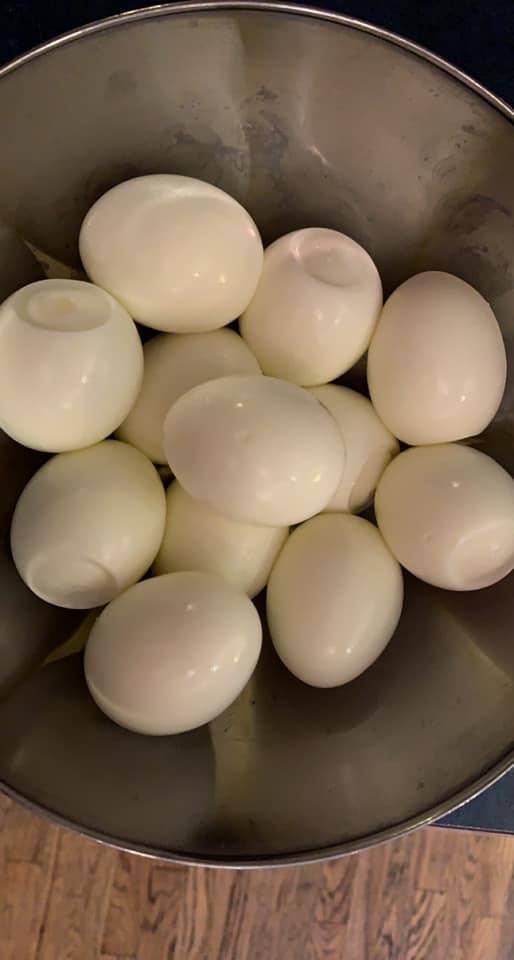ADVERTISEMENT
3. Cracking the Egg
After chilling the eggs, it’s time to peel them. The first step is to gently tap the egg on a hard surface to crack the shell. Don’t be too rough, as you want to avoid damaging the egg white underneath the shell.
4. Peeling the Egg
This is where the magic happens. Here are the best tips for peeling hard-boiled eggs:
- Start from the Wider End: The wider end of the egg typically contains an air pocket, which makes it the easiest place to begin peeling.
- Roll the Egg: After cracking the shell, gently roll the egg between your hands to loosen the shell. This step helps separate the membrane from the egg white.
- Peel Under Running Water: If you’re struggling with bits of shell sticking, peel the egg under a stream of cold running water. The water can help loosen stubborn pieces and wash away any remaining bits of shell. Alternatively, you can peel the egg in a bowl of water for the same effect.
- Be Patient: Take your time and peel carefully to avoid tearing the egg white. If the shell sticks, just go slow, and be gentle with your movements.
5. Enjoy Your Perfectly Peeled Eggs
Once your egg is peeled, you’re ready to enjoy it in any dish! Perfectly peeled hard-boiled eggs are ready to be sliced for a salad, made into deviled eggs, or eaten as is with a sprinkle of salt and pepper.
Tips for Even Better Results
To ensure you get the best results every time, here are a few extra tips to make your hard-boiled eggs even easier to peel:
- Add Baking Soda to the Water: Adding about a teaspoon of baking soda to the water before boiling helps raise the pH level and makes the eggs easier to peel. It’s a simple trick that works wonders, especially for fresher eggs.
- Use Older Eggs When Possible: As mentioned, slightly older eggs (around 5-7 days old) are much easier to peel. If you have the time to plan ahead, opt for eggs that have been sitting in the fridge for a while before boiling.
- Don’t Skip the Ice Bath: The ice bath is essential not only for stopping the cooking process but also for making peeling easier. Cold water helps shrink the egg whites away from the membrane, making it less likely that the shell will stick.
- Crack the Egg Gently: When cracking the egg, use gentle taps, and be mindful not to crush the egg too much. Lightly tapping and rolling will give you the best chances of peeling without breaking the egg white.
- Store Peeled Eggs Correctly: If you have leftover peeled eggs, store them in a container of cold water in the fridge. This helps keep them fresh and prevents them from drying out. Replace the water daily if you plan on storing them for more than a day.
Common Mistakes to Avoid
While hard-boiled eggs may seem simple to make, there are a few common mistakes you should avoid:
- Overcooking: Leaving eggs in hot water too long can lead to a dry, crumbly texture. Follow the recommended times for perfect yolks and whites.
- Not Cooling Quickly Enough: If you don’t cool your eggs promptly with an ice bath, they may continue to cook, which could result in overcooked yolks or rubbery whites.
- Peeling Too Soon: Don’t try to peel the eggs right after boiling. Allow them to cool completely for the easiest and cleanest peel.
Final Thoughts: Perfectly Peeled Hard-Boiled Eggs Are Achievable!
With the right technique and a few helpful tips, you can now master the art of perfectly peeled hard-boiled eggs. Whether you’re making a snack, adding them to a salad, or preparing them for a party platter, these simple steps will ensure that your eggs come out flawlessly every time. By choosing the right eggs, using the proper cooking method, and applying a bit of patience while peeling, you’ll be able to enjoy perfect hard-boiled eggs with ease.
So, grab a pot of water and get cracking (literally)! With these tips in hand, you’re well on your way to making perfectly peeled hard-boiled eggs every time!
ADVERTISEMENT
